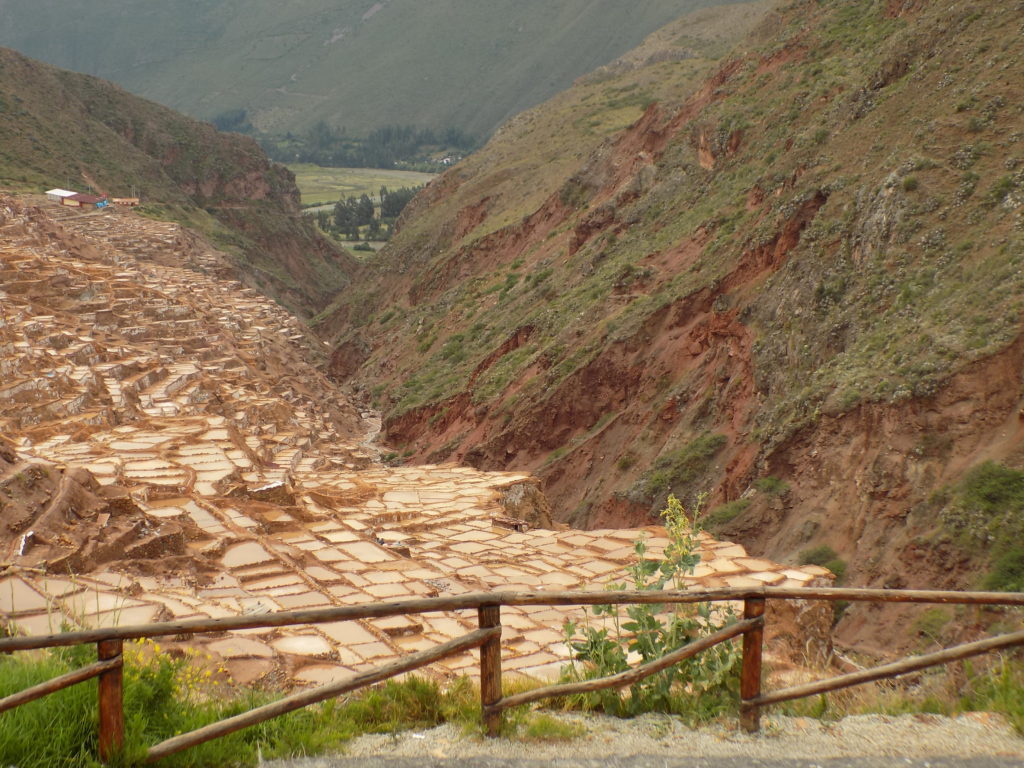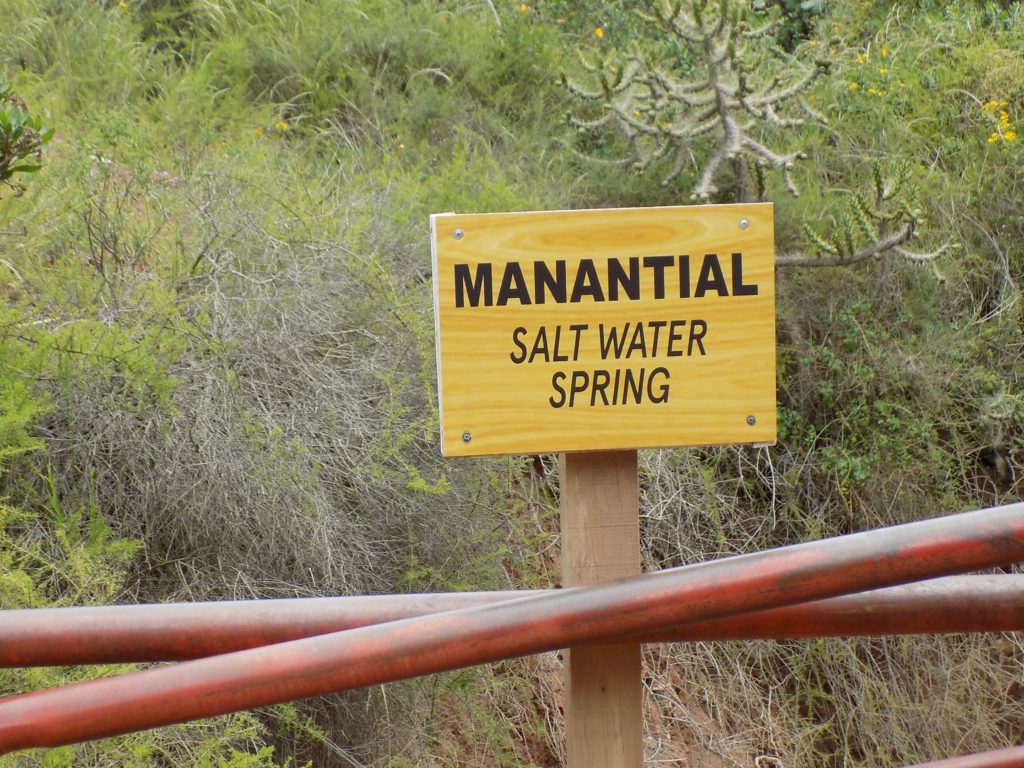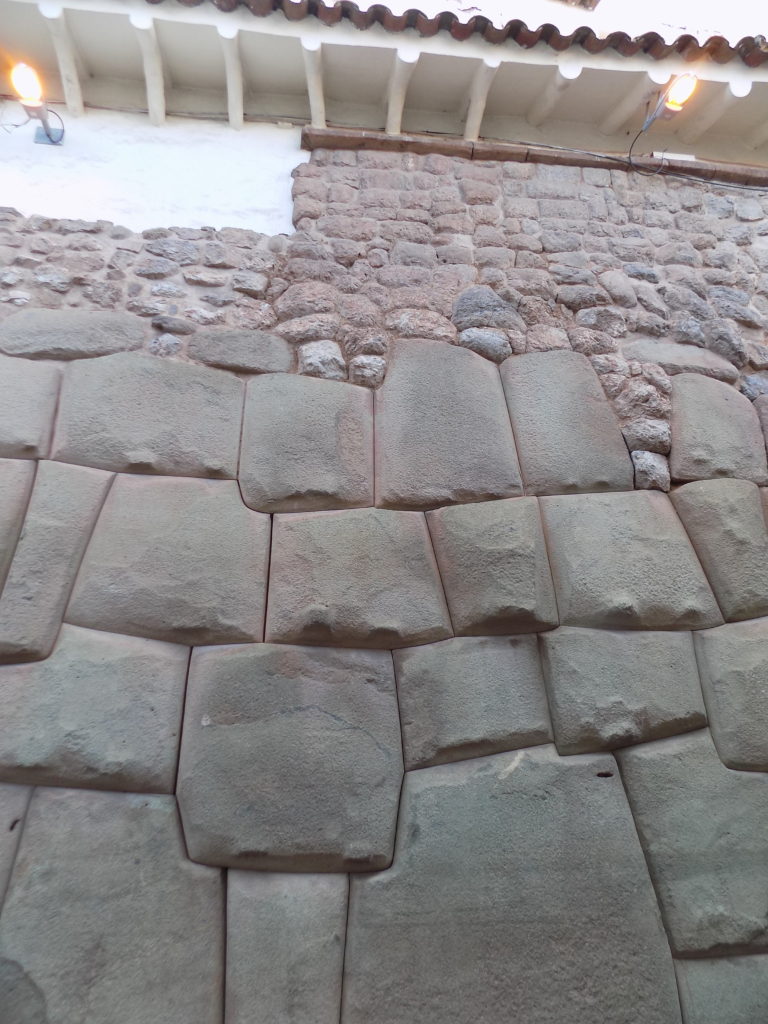I felt a little ambivalent as we prepared to leave Moray. While I wouldn’t necessarily describe our time there as rushed, our guide made certain we stayed on the uppermost level of the site and didn’t stray too far afield. I felt slightly envious of the people I saw exploring the lower levels of the site but I also understood that this would be impractical for me to try. Even as I was growing more acclimated to the altitude, I was still early enough in my transitional phase that, for me, the descent and ascent would likely have required considerable effort and much more time than the tour allowed. (Although the formal structure of Moray is only 30 meters from the top tier to the bottom, the ridge on which we stood was 120 meters above the upper tier. The 150-meter total would be equivalent to climbing up and down the steps of a building 45 to 50 stories tall. Wasn’t gonna happen.)
As we were leaving Moray, a young woman boarded the van offering samples (and bottles for sale) of a local alcoholic drink. I don’t recall if it was a type of spiced chicha (brewed from fermented corn) or some other regional brew. As someone who rarely drinks, I paid little attention (but I did taste it to be polite). Then on the way to the Salineras de Maras, we made another stop at a small shop that was in or near the town of Maras itself where we could buy snacks, souvenirs, and packages of the salt extracted from the salt pans we were about to visit. (I note this because the surfeit of small vendors at the salt pans offered all the same merchandise as this shop. Perhaps the in-town prices were a bit lower. I didn’t comparison shop so, they might also have been higher. A cynical suspicion surfaced that the tour operator had some sort of commission arrangement with the three vendors we had now encountered. On the other hand, everyone’s entitled to make a living and doling out a handful of soles would make no difference in my life.)
Las Salineras de Maras.
The photo above isn’t the first view visitors have of the Maras Salt Pans nor does it provide the best perspective regarding the size of this salt farm. You first see the pans from the road above them as you round switchbacks and pass gaps in the trees. Since our van didn’t stop along the way, the best perspective of its size that I can provide comes from this satellite image taken from Google Maps.
Using the scale on the image, I’d guess they cover an area about 425 meters long by 120 meters wide.
In case you need some assistance from Captain Obvious, the place name and the two photos above make it apparent that these aren’t mines in the way we might normally picture a salt mine. Since they are salt ponds, they must have a source of water and a reasonable question to ponder would be whence a source of salt water at an altitude nearly 3,400 kilometers above sea level and some 700 kilometers inland.
For the geological explanation, you need to recall that the Andes rose relatively quickly through the process of subduction and that they were, at one time, below the ocean surface. Scientists confirmed this in the 1980s when they discovered fossils of whales and other marine mammals at elevations above 1,500 meters. If you also remember that Lake Titikaka is brackish, then the presence of saltwater here isn’t particularly surprising.
If you could ask the Inkas how the salt water came to be they would have told you of the four Ayar brothers – Ayar Manco (whom we have met as Manco Qhapaq), Ayar Uchu, Ayar Auqa, and Ayar Kachi. After the great flood, the four sons of Viracocha emerged from the cave at Paqariq Tampu. Ayar Kachi was the strongest of the four and his brothers feared him. (Or, in another version of the Ayar myth he had a sling or some other weapon that he wielded too frequently and too forcefully.) They tricked him into entering a cave that they then sealed with a rock. The salt water is said to be the tears of Ayar Kachi. It’s also noteworthy that the indigenous people call this region Kachi which is also the Quechua word for salt.
While the Inkas have a mythological tale about the salt water, the salt pans themselves were another acquisition of their expanding empire. The ponds and the method of extracting salt from them dates at least as far back as the Chanapata culture that had its peak between 200 CE and 900 CE.
Workin’ on the salt mine Goin’ down, down, down.
Yes, the Maras salt pans aren’t exactly coal mines but that doesn’t mean that extracting the salt isn’t physically draining and labor intensive.
Looking down at the expanse you can see hundreds (perhaps thousands) of individual ponds. Over time, likely through a process of trial and error, people discovered the optimal size and water depth for them. Each pond is less than four meters square and the water restricted to a depth of 30 centimeters or less.
Salt production and collection generally occurs during the dry season and is done manually with no modern equipment. A notch in one wall of each pond allows its owner to divert water from the stream and fill it to the proper depth. They then wait as the water evaporates under the high sun in the dry Andean air.
Over the course of a month, a crust forms atop the pond, the keeper scrapes off the salt with a wood baton before collecting it and placing it in a basket to drain. Once it’s dry, it’s then packed in bags weighing tens of kilograms and hauled to market.
Visitors are permitted to walk throughout the ponds and interact with the salt farmers and our guide encouraged us to walk as far as we wanted – provided we were in the parking lot by a specific time. (I think it was 14:45 – our scheduled departure time.) With the ponds at different stages of the process seeing them close up would have been interesting.
However, once again out of an abundance of caution, Jill and I decided not to stray too far. We were, however, entertained by one of the vendors as he played haunting melodies (including El Condor Pasa) on his pan flute that reverberated across the valley.
Although the ponds are handed down from generation to generation, it’s said that there are always ponds not in use. So, if you’re interested in becoming a salt miner, here’s what you need to do:
First, you have to move to the community. The ponds are only open to community members who become part of the working cooperative.
Next, you have to locate an empty unmaintained pond. These are likely to be farthest from the community and closer to the bottom of the mine where the water will bring additional sediment and produce a lower quality cloudier salt.
The third step is to meet with the local cooperative, demonstrate that you know how to properly maintain your pond, and agree to work within the communal system.
Finally, start working.
Return to Cusco.
The van left us at a spot a block or two from our departure point but the central part of Cusco isn’t particularly difficult to navigate and we found our way back to the hotel easily. We met Jan and had a brief rest in the lobby. Berner joined us for a supplemental walking tour before dinner.
During the walk he pointed out where some of the Inka palaces had been built and how the bases of many of the buildings retain the 15th or 16th century Inkan stonework
with the less elegant Spanish construction atop it.
Of course, the highlight of this walk was seeing the famous 12 angled stone which is considered part of Perú’s national heritage. You can see a photo of it here.
An acquaintance of mine from Colombia had highly recommended we have dinner at a restaurant called KusiKuy and that was where I anticipated going that night after our walk. Instead, we ended up at a restaurant operated by someone who Berner told us used to work at KusiKuy who also seemed to be his friend. I had a tasty aji de gallina and our host was effusively friendly even pouring us some of his homemade herb flavored liqueur after dinner. I still felt a twinge of guilt knowing I’d have to give Carlos a disappointing report. But the meal and the liquor more than made up for it.
And for those of you who are unfamiliar with the Allen Toussaint classic referenced in one of the section headers above, I give you the original Lee Dorsey 1966 recording.




